2008 NISSAN LATIO light
[x] Cancel search: lightPage 1091 of 2771
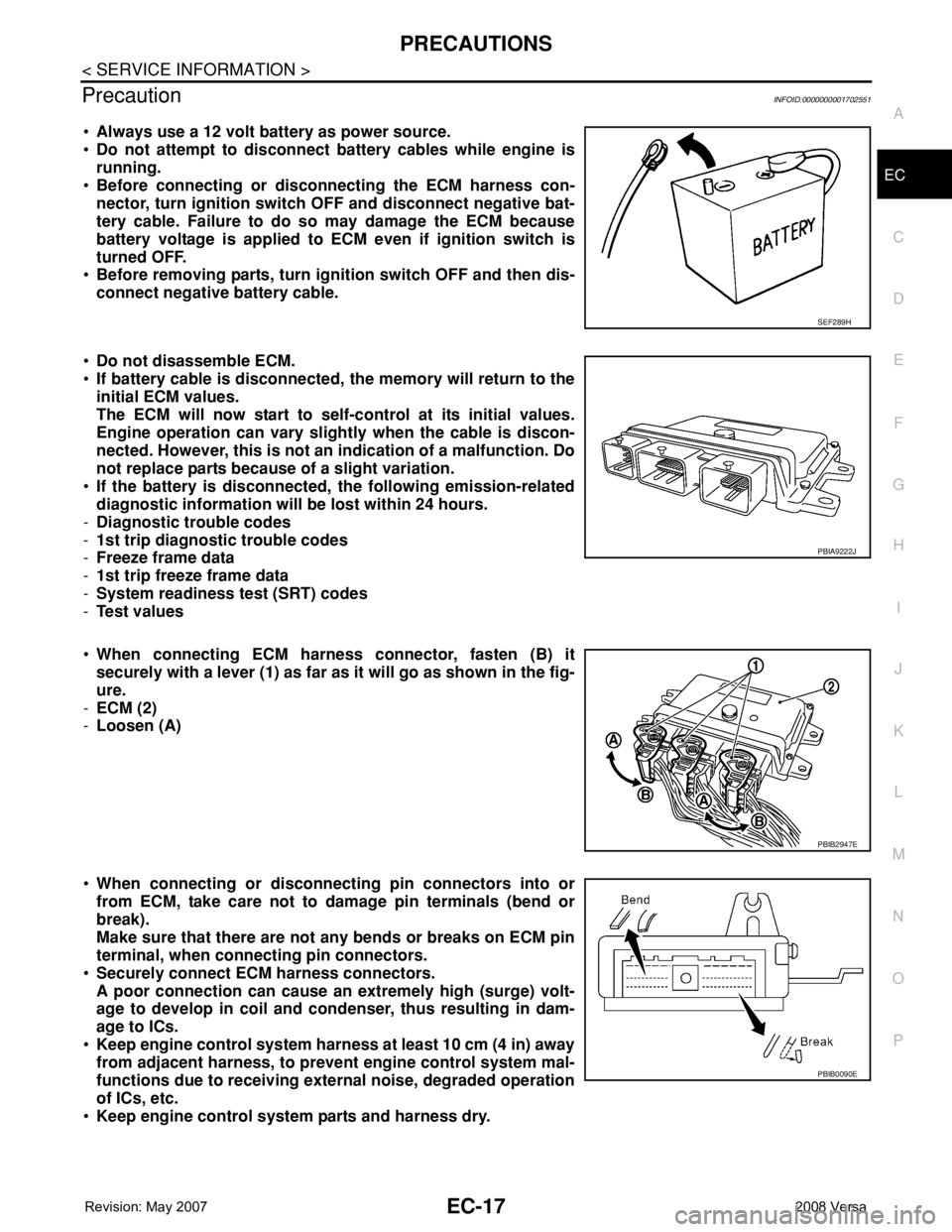
PRECAUTIONS
EC-17
< SERVICE INFORMATION >
C
D
E
F
G
H
I
J
K
L
MA
EC
N
P O
PrecautionINFOID:0000000001702551
•Always use a 12 volt battery as power source.
•Do not attempt to disconnect battery cables while engine is
running.
•Before connecting or disconnecting the ECM harness con-
nector, turn ignition switch OFF and disconnect negative bat-
tery cable. Failure to do so may damage the ECM because
battery voltage is applied to ECM even if ignition switch is
turned OFF.
•Before removing parts, turn ignition switch OFF and then dis-
connect negative battery cable.
•Do not disassemble ECM.
•If battery cable is disconnected, the memory will return to the
initial ECM values.
The ECM will now start to self-control at its initial values.
Engine operation can vary slightly when the cable is discon-
nected. However, this is not an indication of a malfunction. Do
not replace parts because of a slight variation.
•If the battery is disconnected, the following emission-related
diagnostic information will be lost within 24 hours.
-Diagnostic trouble codes
-1st trip diagnostic trouble codes
-Freeze frame data
-1st trip freeze frame data
-System readiness test (SRT) codes
-Test values
•When connecting ECM harness connector, fasten (B) it
securely with a lever (1) as far as it will go as shown in the fig-
ure.
-ECM (2)
-Loosen (A)
•When connecting or disconnecting pin connectors into or
from ECM, take care not to damage pin terminals (bend or
break).
Make sure that there are not any bends or breaks on ECM pin
terminal, when connecting pin connectors.
•Securely connect ECM harness connectors.
A poor connection can cause an extremely high (surge) volt-
age to develop in coil and condenser, thus resulting in dam-
age to ICs.
•Keep engine control system harness at least 10 cm (4 in) away
from adjacent harness, to prevent engine control system mal-
functions due to receiving external noise, degraded operation
of ICs, etc.
•Keep engine control system parts and harness dry.
SEF289H
PBIA9222J
PBIB2947E
PBIB0090E
Page 1092 of 2771

EC-18
< SERVICE INFORMATION >
PRECAUTIONS
•Before replacing ECM, perform “ECM Terminals and Refer-
ence Value” inspection and make sure ECM functions prop-
erly. Refer to EC-102, "
ECM Terminal and Reference Value".
•Handle mass air flow sensor carefully to avoid damage.
•Do not disassemble mass air flow sensor.
•Do not clean mass air flow sensor with any type of detergent.
•Do not disassemble electric throttle control actuator.
•Even a slight leak in the air intake system can cause serious
incidents.
•Do not shock or jar the camshaft position sensor (PHASE),
crankshaft position sensor (POS).
•After performing each TROUBLE DIAGNOSIS, perform DTC
Confirmation Procedure or Overall Function Check.
The DTC should not be displayed in the DTC Confirmation
Procedure if the repair is completed. The Overall Function
Check should be a good result if the repair is completed.
•When measuring ECM signals with a circuit tester, never allow
the two tester probes to contact.
Accidental contact of probes will cause a short circuit and
damage the ECM power transistor.
•Do not use ECM ground terminals when measuring input/out-
put voltage. Doing so may result in damage to the ECM's tran-
sistor. Use a ground other than ECM terminals, such as the
ground.
•Do not operate fuel pump when there is no fuel in lines.
•Tighten fuel hose clamps to the specified torque.
-Fuel level sensor unit and fuel pump (1)
-Fuel pressure regulator (2)
-Fuel level sensor (3)
-Fuel tank temperature sensor (4)
MEF040D
SEF217U
SEF348N
BBIA0704E
Page 1102 of 2771

EC-28
< SERVICE INFORMATION >
AUTOMATIC SPEED CONTROL DEVICE (ASCD)
AUTOMATIC SPEED CONTROL DEVICE (ASCD)
System DescriptionINFOID:0000000001702560
INPUT/OUTPUT SIGNAL CHART
*: This signal is sent to the ECM through CAN communication line.
BASIC ASCD SYSTEM
Refer to Owner's Manual for ASCD operating instructions.
Automatic Speed Control Device (ASCD) allows a driver to keep vehicle at predetermined constant speed
without depressing accelerator pedal. Driver can set vehicle speed in advance between approximately 40 km/
h (25 MPH) and 144 km/h (89 MPH).
ECM controls throttle angle of electric throttle control actuator to regulate engine speed.
Operation status of ASCD is indicated by CRUISE indicator and SET indicator in combination meter. If any
malfunction occurs in ASCD system, it automatically deactivates control.
NOTE:
Always drive vehicle in safe manner according to traffic conditions and obey all traffic laws.
SET OPERATION
Press MAIN switch. (The CRUISE indicator in combination meter illuminates.)
When vehicle speed reaches a desired speed between approximately 40 km/h (25 MPH) and 144 km/h (89
MPH), press SET/COAST switch. (Then SET indicator in combination meter illuminates.)
ACCELERATE OPERATION
If the RESUME/ACCELERATE switch is depressed during cruise control driving, increase the vehicle speed
until the switch is released or vehicle speed reaches maximum speed controlled by the system.
And then ASCD will keep the new set speed.
CANCEL OPERATION
When any of following conditions exist, cruise operation will be canceled.
• CANCEL switch is pressed
• More than two switches at ASCD steering switch are pressed at the same time (Set speed will be cleared)
• Brake pedal is depressed
• Clutch pedal is depressed or gear position is changed to the neutral position (M/T models)
• Selector lever is changed to N, P, R position (A/T and CVT models)
• Vehicle speed decreased to 13 km/h (8 MPH) lower than the set speed
When the ECM detects any of the following conditions, the ECM will cancel the cruise operation and inform
the driver by blinking indicator lamp.
• Engine coolant temperature is slightly higher than the normal operating temperature, CRUISE lamp may
blink slowly.
When the engine coolant temperature decreases to the normal operating temperature, CRUISE lamp will
stop blinking and the cruise operation will be able to work by pressing SET/COAST switch or RESUME/
ACCELERATE switch.
• Malfunction for some self-diagnoses regarding ASCD control: SET lamp will blink quickly.
If MAIN switch is turned to OFF during ASCD is activated, all of ASCD operations will be canceled and vehicle
speed memory will be erased.
COAST OPERATION
When the SET/COAST switch is depressed during cruise control driving, decrease vehicle set speed until the
switch is released. And then ASCD will keep the new set speed.
Sensor Input signal to ECM ECM function Actuator
ASCD brake switch Brake pedal operation
ASCD vehicle speed controlElectric throttle control
actuator Stop lamp switch Brake pedal operation
ASCD clutch switch (M/T models) Clutch pedal operation
ASCD steering switch ASCD steering switch operation
Park/neutral position (PNP) switch Gear position
Combination meter Vehicle speed*
TCM (A/T and CVT models) Powertrain revolution*
Page 1119 of 2771
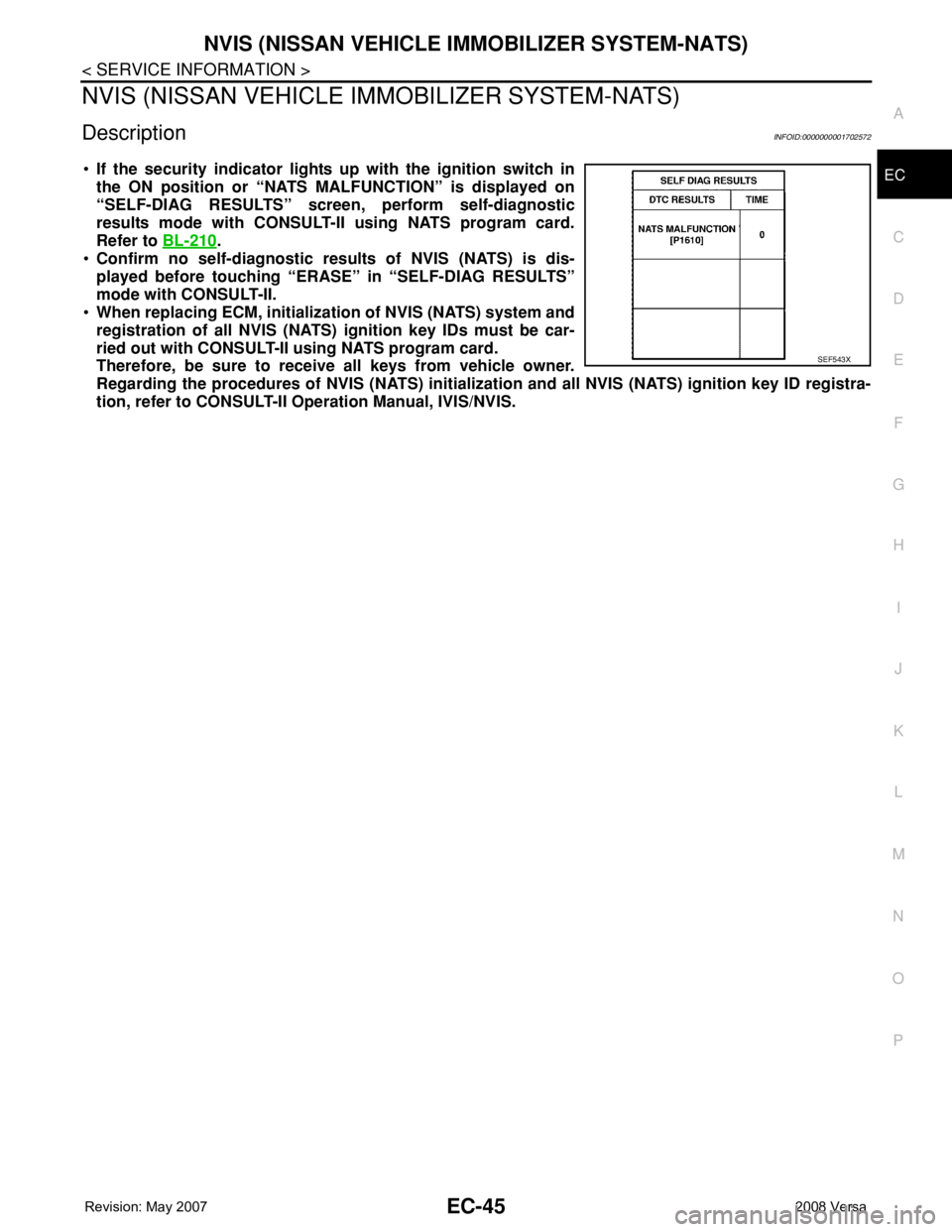
NVIS (NISSAN VEHICLE IMMOBILIZER SYSTEM-NATS)
EC-45
< SERVICE INFORMATION >
C
D
E
F
G
H
I
J
K
L
MA
EC
N
P O
NVIS (NISSAN VEHICLE IMMOBILIZER SYSTEM-NATS)
DescriptionINFOID:0000000001702572
•If the security indicator lights up with the ignition switch in
the ON position or “NATS MALFUNCTION” is displayed on
“SELF-DIAG RESULTS” screen, perform self-diagnostic
results mode with CONSULT-II using NATS program card.
Refer to BL-210
.
•Confirm no self-diagnostic results of NVIS (NATS) is dis-
played before touching “ERASE” in “SELF-DIAG RESULTS”
mode with CONSULT-II.
•When replacing ECM, initialization of NVIS (NATS) system and
registration of all NVIS (NATS) ignition key IDs must be car-
ried out with CONSULT-II using NATS program card.
Therefore, be sure to receive all keys from vehicle owner.
Regarding the procedures of NVIS (NATS) initialization and all NVIS (NATS) ignition key ID registra-
tion, refer to CONSULT-II Operation Manual, IVIS/NVIS.
SEF543X
Page 1120 of 2771
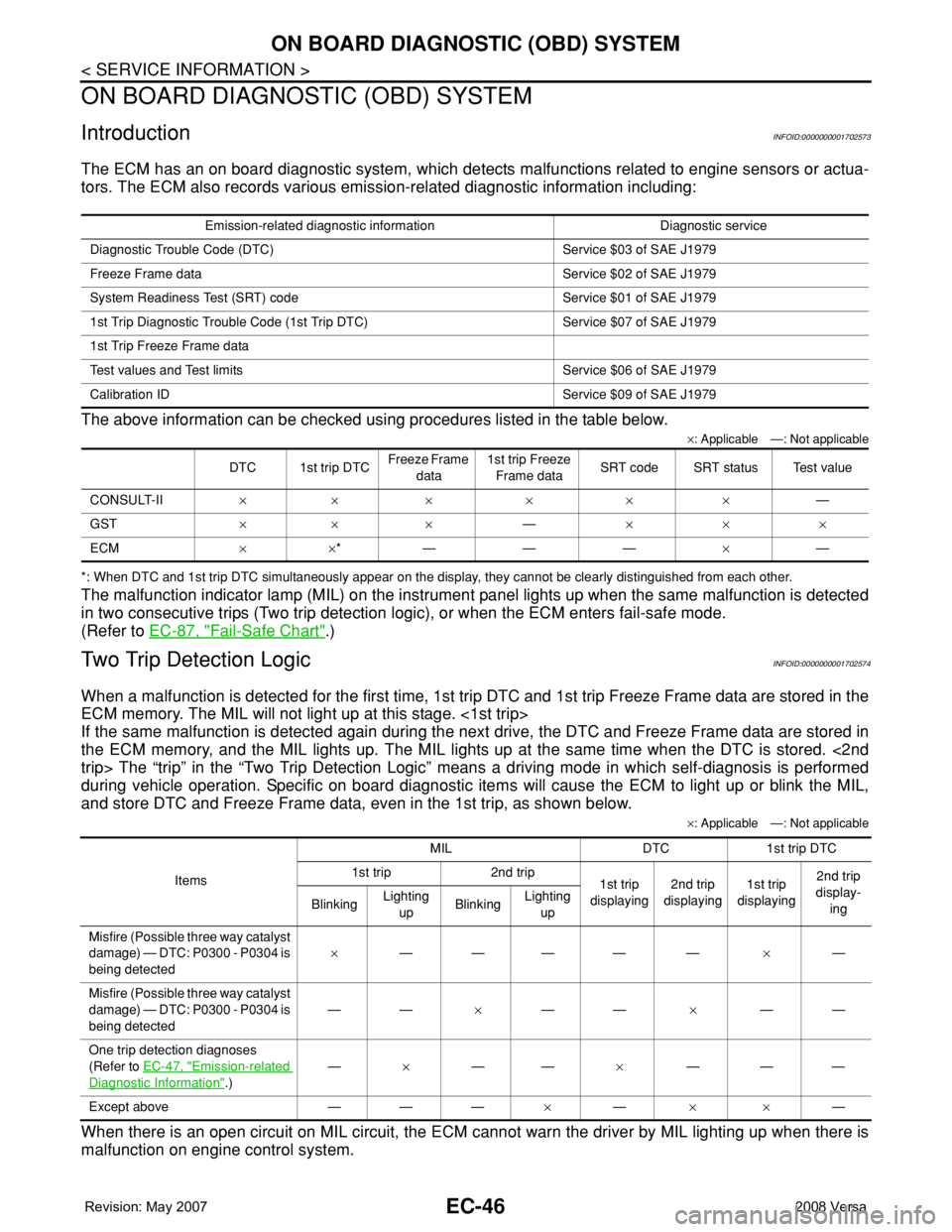
EC-46
< SERVICE INFORMATION >
ON BOARD DIAGNOSTIC (OBD) SYSTEM
ON BOARD DIAGNOSTIC (OBD) SYSTEM
IntroductionINFOID:0000000001702573
The ECM has an on board diagnostic system, which detects malfunctions related to engine sensors or actua-
tors. The ECM also records various emission-related diagnostic information including:
The above information can be checked using procedures listed in the table below.
×: Applicable —: Not applicable
*: When DTC and 1st trip DTC simultaneously appear on the display, they cannot be clearly distinguished from each other.
The malfunction indicator lamp (MIL) on the instrument panel lights up when the same malfunction is detected
in two consecutive trips (Two trip detection logic), or when the ECM enters fail-safe mode.
(Refer to EC-87, "
Fail-Safe Chart".)
Two Trip Detection LogicINFOID:0000000001702574
When a malfunction is detected for the first time, 1st trip DTC and 1st trip Freeze Frame data are stored in the
ECM memory. The MIL will not light up at this stage. <1st trip>
If the same malfunction is detected again during the next drive, the DTC and Freeze Frame data are stored in
the ECM memory, and the MIL lights up. The MIL lights up at the same time when the DTC is stored. <2nd
trip> The “trip” in the “Two Trip Detection Logic” means a driving mode in which self-diagnosis is performed
during vehicle operation. Specific on board diagnostic items will cause the ECM to light up or blink the MIL,
and store DTC and Freeze Frame data, even in the 1st trip, as shown below.
×: Applicable —: Not applicable
When there is an open circuit on MIL circuit, the ECM cannot warn the driver by MIL lighting up when there is
malfunction on engine control system.
Emission-related diagnostic information Diagnostic service
Diagnostic Trouble Code (DTC) Service $03 of SAE J1979
Freeze Frame data Service $02 of SAE J1979
System Readiness Test (SRT) code Service $01 of SAE J1979
1st Trip Diagnostic Trouble Code (1st Trip DTC) Service $07 of SAE J1979
1st Trip Freeze Frame data
Test values and Test limits Service $06 of SAE J1979
Calibration ID Service $09 of SAE J1979
DTC 1st trip DTCFreeze Frame
data1st trip Freeze
Frame dataSRT code SRT status Test value
CONSULT-II××××××—
GST×× ×—×××
ECM××*———×—
ItemsMIL DTC 1st trip DTC
1st trip 2nd trip
1st trip
displaying2nd trip
displaying1st trip
displaying2nd trip
display-
ing BlinkingLighting
upBlinkingLighting
up
Misfire (Possible three way catalyst
damage) — DTC: P0300 - P0304 is
being detected×———— —×—
Misfire (Possible three way catalyst
damage) — DTC: P0300 - P0304 is
being detected——×——×——
One trip detection diagnoses
(Refer to EC-47, "
Emission-related
Diagnostic Information".)—×——×———
Except above — — —×—××—
Page 1121 of 2771
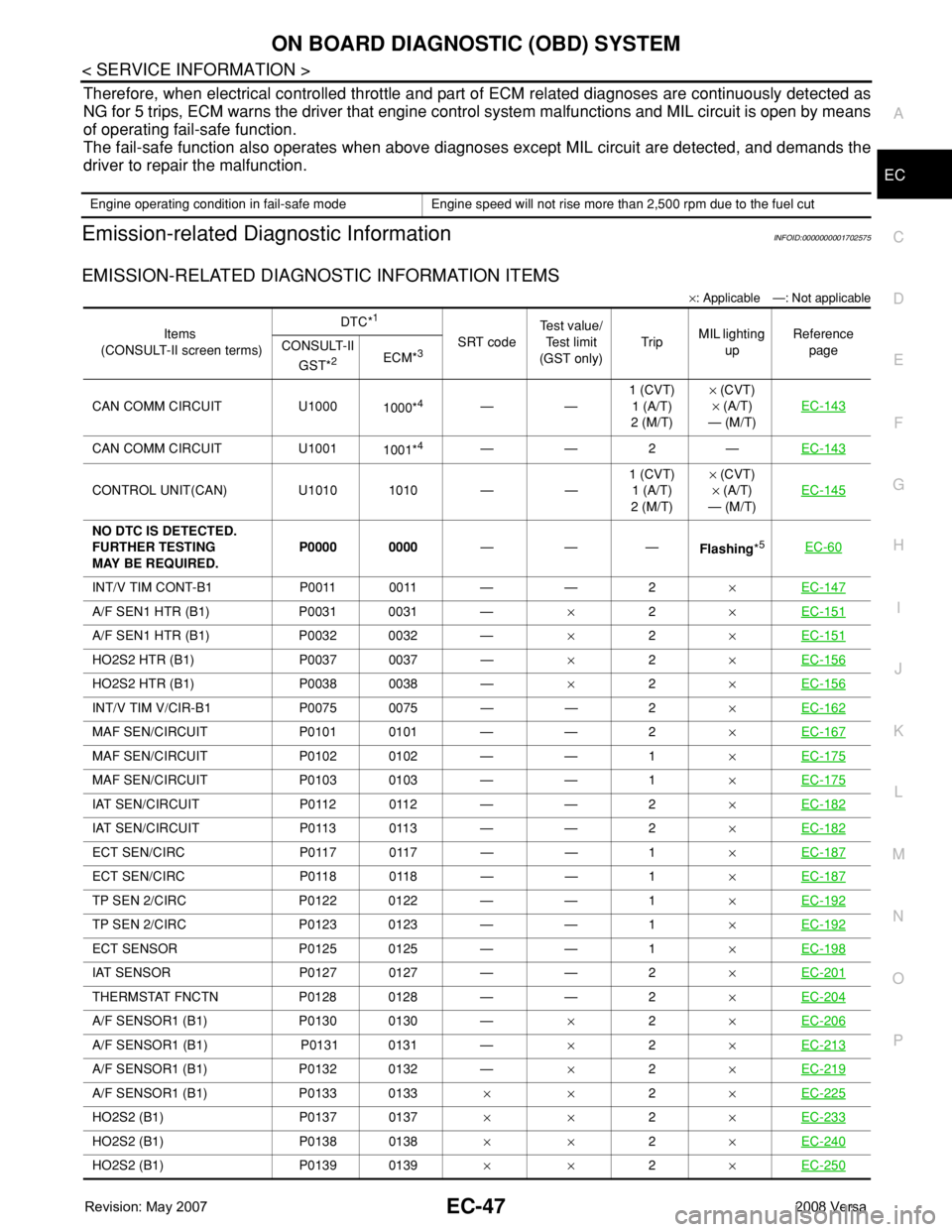
ON BOARD DIAGNOSTIC (OBD) SYSTEM
EC-47
< SERVICE INFORMATION >
C
D
E
F
G
H
I
J
K
L
MA
EC
N
P O
Therefore, when electrical controlled throttle and part of ECM related diagnoses are continuously detected as
NG for 5 trips, ECM warns the driver that engine control system malfunctions and MIL circuit is open by means
of operating fail-safe function.
The fail-safe function also operates when above diagnoses except MIL circuit are detected, and demands the
driver to repair the malfunction.
Emission-related Diagnostic InformationINFOID:0000000001702575
EMISSION-RELATED DIAGNOSTIC INFORMATION ITEMS
×: Applicable —: Not applicable
Engine operating condition in fail-safe mode Engine speed will not rise more than 2,500 rpm due to the fuel cut
Items
(CONSULT-II screen terms)DTC*
1
SRT codeTest value/
Test limit
(GST only)TripMIL lighting
upReference
page CONSULT-II
GST*
2ECM*3
CAN COMM CIRCUIT U1000
1000*4——1 (CVT)
1 (A/T)
2 (M/T)× (CVT)
× (A/T)
— (M/T)EC-143
CAN COMM CIRCUIT U1001
1001*4——2—EC-143
CONTROL UNIT(CAN) U1010 1010 — —1 (CVT)
1 (A/T)
2 (M/T)× (CVT)
× (A/T)
— (M/T)EC-145
NO DTC IS DETECTED.
FURTHER TESTING
MAY BE REQUIRED.P0000 0000———
Flashing*5EC-60
INT/V TIM CONT-B1 P0011 0011 — — 2×EC-147
A/F SEN1 HTR (B1) P0031 0031 —×2×EC-151
A/F SEN1 HTR (B1) P0032 0032 —×2×EC-151
HO2S2 HTR (B1) P0037 0037 —×2×EC-156
HO2S2 HTR (B1) P0038 0038 —×2×EC-156
INT/V TIM V/CIR-B1 P0075 0075 — — 2×EC-162
MAF SEN/CIRCUIT P0101 0101 — — 2×EC-167
MAF SEN/CIRCUIT P0102 0102 — — 1×EC-175
MAF SEN/CIRCUIT P0103 0103 — — 1×EC-175
IAT SEN/CIRCUIT P0112 0112 — — 2×EC-182
IAT SEN/CIRCUIT P0113 0113 — — 2×EC-182
ECT SEN/CIRC P0117 0117 — — 1×EC-187
ECT SEN/CIRC P0118 0118 — — 1×EC-187
TP SEN 2/CIRC P0122 0122 — — 1×EC-192
TP SEN 2/CIRC P0123 0123 — — 1×EC-192
ECT SENSOR P0125 0125 — — 1×EC-198
IAT SENSOR P0127 0127 — — 2×EC-201
THERMSTAT FNCTN P0128 0128 — — 2×EC-204
A/F SENSOR1 (B1) P0130 0130 —×2×EC-206
A/F SENSOR1 (B1) P0131 0131 —×2×EC-213
A/F SENSOR1 (B1) P0132 0132 —×2×EC-219
A/F SENSOR1 (B1) P0133 0133××2×EC-225
HO2S2 (B1) P0137 0137××2×EC-233
HO2S2 (B1) P0138 0138××2×EC-240
HO2S2 (B1) P0139 0139××2×EC-250
Page 1122 of 2771
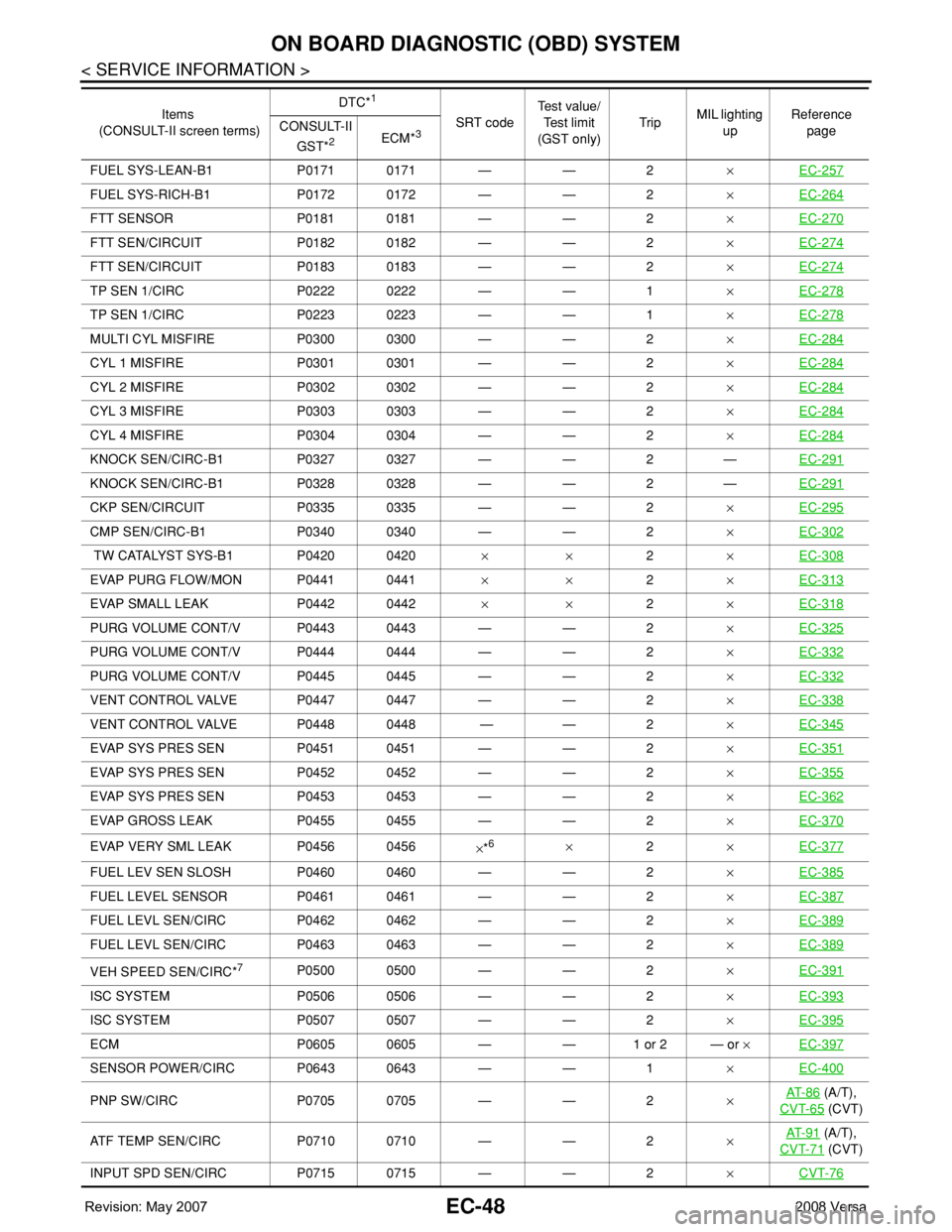
EC-48
< SERVICE INFORMATION >
ON BOARD DIAGNOSTIC (OBD) SYSTEM
FUEL SYS-LEAN-B1 P0171 0171 — — 2×EC-257
FUEL SYS-RICH-B1 P0172 0172 — — 2×EC-264
FTT SENSOR P0181 0181 — — 2×EC-270
FTT SEN/CIRCUIT P0182 0182 — — 2×EC-274
FTT SEN/CIRCUIT P0183 0183 — — 2×EC-274
TP SEN 1/CIRC P0222 0222 — — 1×EC-278
TP SEN 1/CIRC P0223 0223 — — 1×EC-278
MULTI CYL MISFIRE P0300 0300 — — 2×EC-284
CYL 1 MISFIRE P0301 0301 — — 2×EC-284
CYL 2 MISFIRE P0302 0302 — — 2×EC-284
CYL 3 MISFIRE P0303 0303 — — 2×EC-284
CYL 4 MISFIRE P0304 0304 — — 2×EC-284
KNOCK SEN/CIRC-B1 P0327 0327 — — 2 —EC-291
KNOCK SEN/CIRC-B1 P0328 0328 — — 2 —EC-291
CKP SEN/CIRCUIT P0335 0335 — — 2×EC-295
CMP SEN/CIRC-B1 P0340 0340 — — 2×EC-302
TW CATALYST SYS-B1 P0420 0420× ×2×EC-308
EVAP PURG FLOW/MON P0441 0441××2×EC-313
EVAP SMALL LEAK P0442 0442××2×EC-318
PURG VOLUME CONT/V P0443 0443 — — 2×EC-325
PURG VOLUME CONT/V P0444 0444 — — 2×EC-332
PURG VOLUME CONT/V P0445 0445 — — 2×EC-332
VENT CONTROL VALVE P0447 0447 — — 2×EC-338
VENT CONTROL VALVE P0448 0448 — — 2×EC-345
EVAP SYS PRES SEN P0451 0451 — — 2×EC-351
EVAP SYS PRES SEN P0452 0452 — — 2×EC-355
EVAP SYS PRES SEN P0453 0453 — — 2×EC-362
EVAP GROSS LEAK P0455 0455 — — 2×EC-370
EVAP VERY SML LEAK P0456 0456
×*6×2×EC-377
FUEL LEV SEN SLOSH P0460 0460 — — 2×EC-385
FUEL LEVEL SENSOR P0461 0461 — — 2×EC-387
FUEL LEVL SEN/CIRC P0462 0462 — — 2×EC-389
FUEL LEVL SEN/CIRC P0463 0463 — — 2×EC-389
VEH SPEED SEN/CIRC*7P0500 0500 — — 2×EC-391
ISC SYSTEM P0506 0506 — — 2×EC-393
ISC SYSTEM P0507 0507 — — 2×EC-395
ECM P0605 0605 — — 1 or 2 — or ×EC-397
SENSOR POWER/CIRC P0643 0643 — — 1×EC-400
PNP SW/CIRC P0705 0705 — — 2×AT- 8 6 (A/T),
CVT-65
(CVT)
ATF TEMP SEN/CIRC P0710 0710 — — 2×AT- 9 1
(A/T),
CVT-71
(CVT)
INPUT SPD SEN/CIRC P0715 0715 — — 2×CVT-76
Items
(CONSULT-II screen terms)DTC*
1
SRT codeTest value/
Test limit
(GST only)TripMIL lighting
upReference
page CONSULT-II
GST*
2ECM*3
Page 1123 of 2771
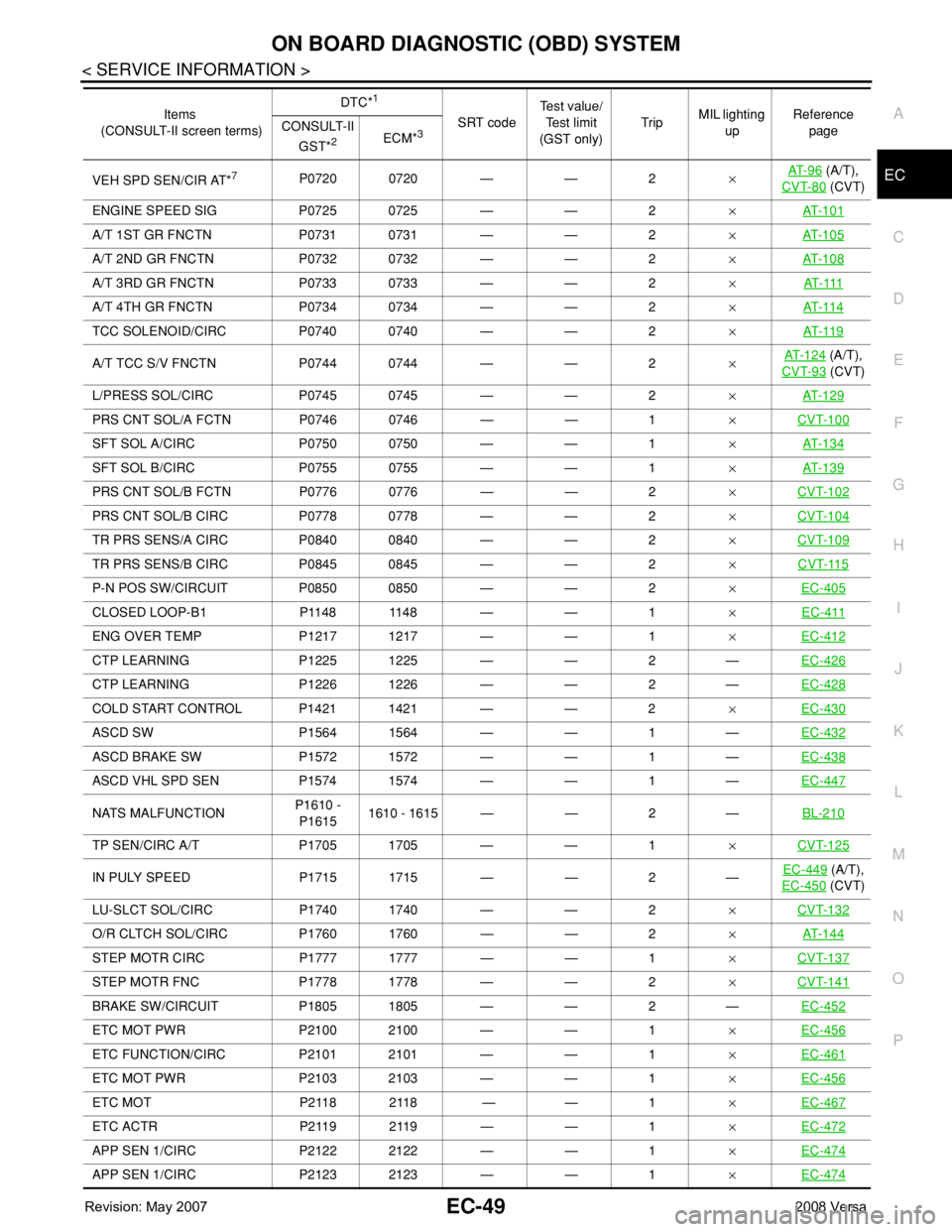
ON BOARD DIAGNOSTIC (OBD) SYSTEM
EC-49
< SERVICE INFORMATION >
C
D
E
F
G
H
I
J
K
L
MA
EC
N
P OVEH SPD SEN/CIR AT*7P0720 0720 — — 2×AT- 9 6 (A/T),
CVT-80
(CVT)
ENGINE SPEED SIG P0725 0725 — — 2×AT- 1 0 1
A/T 1ST GR FNCTN P0731 0731 — — 2×AT- 1 0 5
A/T 2ND GR FNCTN P0732 0732 — — 2×AT- 1 0 8
A/T 3RD GR FNCTN P0733 0733 — — 2×AT- 111
A/T 4TH GR FNCTN P0734 0734 — — 2×AT- 11 4
TCC SOLENOID/CIRC P0740 0740 — — 2×AT- 11 9
A/T TCC S/V FNCTN P0744 0744 — — 2×AT- 1 2 4 (A/T),
CVT-93
(CVT)
L/PRESS SOL/CIRC P0745 0745 — — 2×AT- 1 2 9
PRS CNT SOL/A FCTN P0746 0746 — — 1×CVT-100
SFT SOL A/CIRC P0750 0750 — — 1×AT- 1 3 4
SFT SOL B/CIRC P0755 0755 — — 1×AT- 1 3 9
PRS CNT SOL/B FCTN P0776 0776 — — 2×CVT-102
PRS CNT SOL/B CIRC P0778 0778 — — 2×CVT-104
TR PRS SENS/A CIRC P0840 0840 — — 2×CVT-109
TR PRS SENS/B CIRC P0845 0845 — — 2×CVT-115
P-N POS SW/CIRCUIT P0850 0850 — — 2×EC-405
CLOSED LOOP-B1 P1148 1148 — — 1×EC-411
ENG OVER TEMP P1217 1217 — — 1×EC-412
CTP LEARNING P1225 1225 — — 2 —EC-426
CTP LEARNING P1226 1226 — — 2 —EC-428
COLD START CONTROL P1421 1421 — — 2×EC-430
ASCD SW P1564 1564 — — 1 —EC-432
ASCD BRAKE SW P1572 1572 — — 1 —EC-438
ASCD VHL SPD SEN P1574 1574 — — 1 —EC-447
NATS MALFUNCTIONP1610 -
P16151610 - 1615 — — 2 —BL-210
TP SEN/CIRC A/T P1705 1705 — — 1×CVT-125
IN PULY SPEED P1715 1715 — — 2 —EC-449 (A/T),
EC-450
(CVT)
LU-SLCT SOL/CIRC P1740 1740 — — 2×CVT-132
O/R CLTCH SOL/CIRC P1760 1760 — — 2×AT- 1 4 4
STEP MOTR CIRC P1777 1777 — — 1×CVT-137
STEP MOTR FNC P1778 1778 — — 2×CVT-141
BRAKE SW/CIRCUIT P1805 1805 — — 2 —EC-452
ETC MOT PWR P2100 2100 — — 1×EC-456
ETC FUNCTION/CIRC P2101 2101 — — 1×EC-461
ETC MOT PWR P2103 2103 — — 1×EC-456
ETC MOT P2118 2118 — — 1×EC-467
ETC ACTR P2119 2119 — — 1×EC-472
APP SEN 1/CIRC P2122 2122 — — 1×EC-474
APP SEN 1/CIRC P2123 2123 — — 1×EC-474
Items
(CONSULT-II screen terms)DTC*
1
SRT codeTest value/
Test limit
(GST only)TripMIL lighting
upReference
page CONSULT-II
GST*
2ECM*3